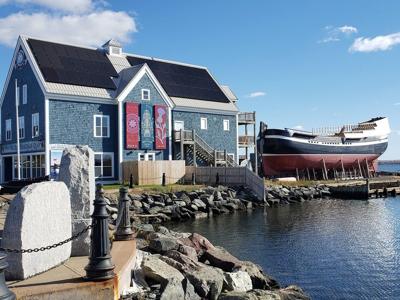PICTOU - A restored replica of the square-rigged sailing ship that sparked a wave of Scottish immigration to Nova Scotia more than 250 years ago was relaunched Saturday with a mighty splash into Pictou harbour.
After a restoration and public fundraising effort that began in 2019, the rebuilt hull of the Hector was eased into the water sideways during a colourful ceremony on the townÔÇÖs scenic waterfront.
During the launch, the vessel was guided down seven ramps, known as launchways, after supporting wedges were removed ÔÇö a process master shipbuilder Vern Shea described as a sight to see.
ÔÇťItÔÇÖs kind of nerve-wracking,ÔÇŁ Shea said in a recent interview. ÔÇťIÔÇÖve witnessed quite a few launches in my career, and you always get the hair on the back of your neck rising and the goosebumps every time you see it.ÔÇŁ
Shea was instrumental in the original build of the Hector replica, which was not fit for sailing, and was installed 25 years ago, next to the interpretive centre and outbuildings of the Hector Heritage Quay.
The wooden vessel was built from the original designs, using traditional methods and materials, Shea said. Over the years, the vessel wasn’t properly maintained and fell into disrepair before the Ship Hector Society bought it for a few dollars in 2010 from the town of Pictou.
The society has spearheaded a $4 million fundraising effort for the latest restoration, which required an extensive rebuild to transform the Hector into a fully working sailing vessel.
ÔÇťIt was the vision to sail it. ItÔÇÖs been my hope all this time,ÔÇŁ said Shea. ÔÇťItÔÇÖs becoming a reality, which is very fulfilling.ÔÇŁ
Shea, who also worked on the engineering drawings for the rebuild of Nova ScotiaÔÇÖs iconic schooner Bluenose II, said the latest rebuild of the Hector required all of the hull planking above the shipÔÇÖs waterline to be removed and replaced because of rot. The ship was then covered in fibreglass for added protection.
ÔÇťWe replaced all of the rotten planks up to the main deck with Douglas fir planking and then we filled the seams with pine and then used two layers of fibreglass,ÔÇŁ Shea said.
Inside the hull are two cramped compartments built as they would have been in 1773, when 189 men, women and children made the harrowing 11-week voyage across the Atlantic Ocean. Smallpox claimed 18 lives during the journey.
ÔÇťIt would have been disgusting, thereÔÇÖs no two ways about it,ÔÇŁ said Shea.
On its website, the Ship Hector Society says those who arrived aboard the Hector made “enormous cultural, political, intellectual and industrial contributions that shaped Nova Scotia and the rest of Canada.ÔÇŁ
SaturdayÔÇÖs launch was attended by several dignitaries, such as Nova Scotia Premier Tim Houston, federal Attorney General Sean Fraser and Chief Tamara Young of the Pictou Landing First Nation.
Young said the arrival of Scottish settlers in northeastern Nova Scotia in 1773 changed the course of history for ÔÇťeveryone who calls this land home.ÔÇŁ
ÔÇťFor us as MiÔÇÖkmaq, our story does not begin with that ship. It began long before with thousands of years of life, culture and knowledge,ÔÇŁ she said. ÔÇťThe launch of this new ship, Hector, gives us an opportunity not just to commemorate the past, but to shape a better future.ÔÇŁ
Now that the ship is in the water and as more funding becomes available, the next phase of the project will begin, such as installing electric motors, masts and sails. ItÔÇÖs hoped the refurbished Hector will be ready for harbour tours by 2027, said society chair Wes Surett.┬á
He said just over $2 million in public funds had been raised so far for the project, with another $1.8 million to go to finish the ship. 
On Saturday, that effort got an added boost with a donation of $1.25 million, announced by David Sobey from the Sobeys grocery chain and co-chair of the Hector capital campaign.
Surett said the interpretive centre opened last month after an extensive revamp through funding from the federal and provincial governments.
Future plans for the site also include the addition of a sailing program, along with a wooden shipbuilding school. 
Surett said a Hector that can finally set sail will be the real money-maker.
ÔÇťWe really see it (the ship) and that sailing experience generating the revenue to sustain the attraction long-term,ÔÇŁ he said.
This report by The Canadian Press was first published July 12, 2025.
ÔÇö By Keith Doucette in Halifax




























To join the conversation set a first and last name in your user profile.
Sign in or register for free to join the Conversation